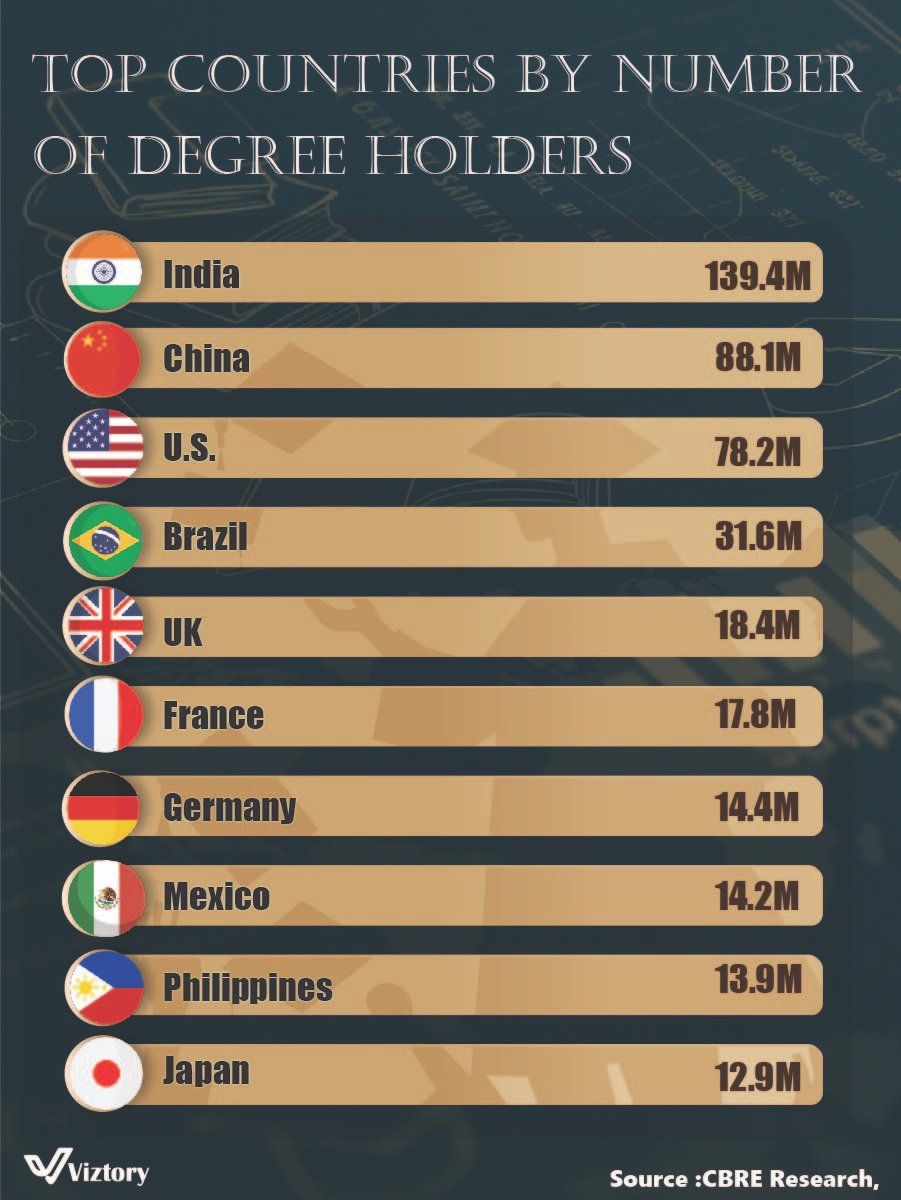TOP COUNTRIES BY NUMBER OF DEGREE HOLDERS
Introduction
Education is a cornerstone of economic development and innovation. The image above, sourced from CBRE Research and visualized by Viztory, ranks the top 10 countries by the number of degree holders. With a surprising lead, India tops the list, followed by China and the United States. This ranking gives insight not only into educational infrastructure but also population size, access to higher education, and economic ambition.
Overview of the Rankings
| Country | Degree Holders (in millions) |
|---|---|
| India | 139.4M |
| China | 88.1M |
| U.S. | 78.2M |
| Brazil | 31.6M |
| UK | 18.4M |
| France | 17.8M |
| Germany | 14.4M |
| Mexico | 14.2M |
| Philippines | 13.9M |
| Japan | 12.9M |
Education and the Economy: A MONEY Perspective
Degrees and Economic Growth
Degree holders are a powerful economic engine. Countries with more educated citizens often enjoy:
-
Higher GDP per capita
-
Stronger innovation sectors
-
Higher foreign investment interest
India’s massive number (139.4 million) may not yet fully reflect in its GDP per capita, but it demonstrates vast potential. The human capital in these countries is a magnet for global companies, especially in IT, R&D, and engineering.
Degree = Higher Income?
While degrees often lead to better-paying jobs, the return on investment (ROI) varies greatly by country:
-
In developed nations like the U.S., UK, and Germany, a degree can drastically increase lifetime earnings.
-
In emerging markets like Brazil, Mexico, and the Philippines, wages remain modest despite qualifications, though the degree still plays a pivotal role in employment access.
Spending on Higher Education
Let’s tie this to MONEY again—countries with more graduates also tend to invest heavily in education:
-
The U.S. spends over $30,000 per student in tertiary education.
-
In contrast, India and China have more cost-efficient systems, producing high volumes of graduates with lower per capita spending.
Unique Observations
-
India’s dominance: Driven by population size and a surge in affordable universities.
-
China vs. U.S.: China surpassed the U.S. in degree holders as more universities expanded post-2000s.
-
European countries dominate the middle tier, reflecting mature and balanced educational ecosystems.
-
Japan’s position at the bottom may surprise some—this reflects demographic trends and a shrinking youth population.
Critical Analysis
Quantity vs. Quality:
While this chart ranks countries by total number of degree holders, it does not account for the quality of education or field of study. A nation may produce millions of graduates, but if most degrees are in low-demand areas or from unaccredited institutions, the economic impact may be limited.
Population-Adjusted Rankings:
Smaller countries with high-quality education systems (e.g., Finland, South Korea, Canada) don’t appear here because of their size, despite having higher per-capita degree rates.
Global Workforce Trends:
Many multinational companies now offshore white-collar jobs to countries like India and the Philippines, partly due to their massive talent pools. This makes the data not just educational—but deeply financial and strategic.
Conclusion
The number of degree holders is not just an education metric—it’s a reflection of a country’s economic ambition, policy priorities, and global competitiveness. Countries like India and China are redefining global labor markets, while traditional powerhouses like the U.S., UK, and Germany continue to invest heavily in maintaining their educational edge.
Understanding these numbers through the lens of money, opportunity, and strategic growth is essential for policymakers, investors, and educators worldwide.

